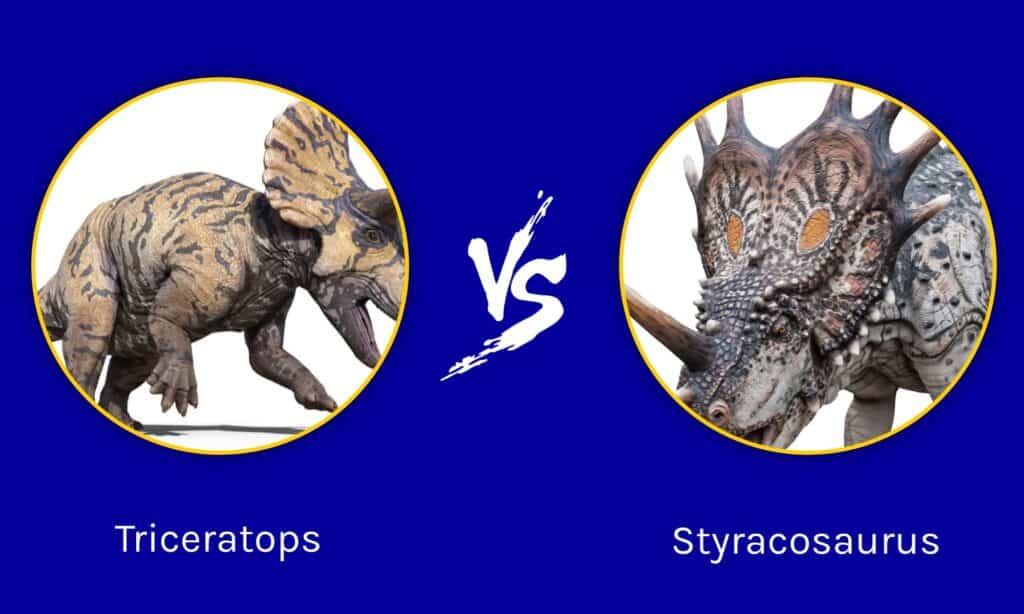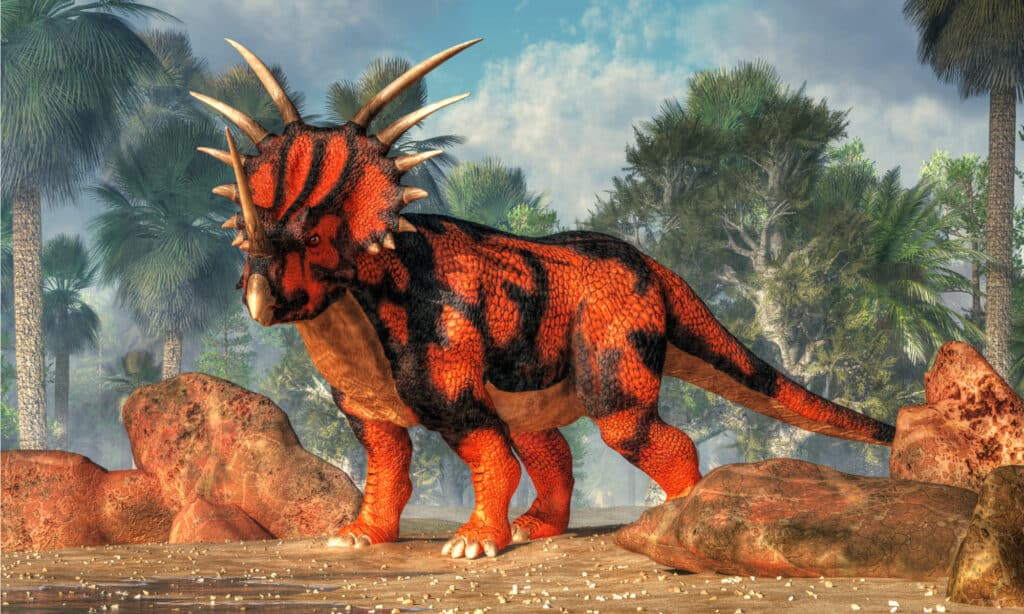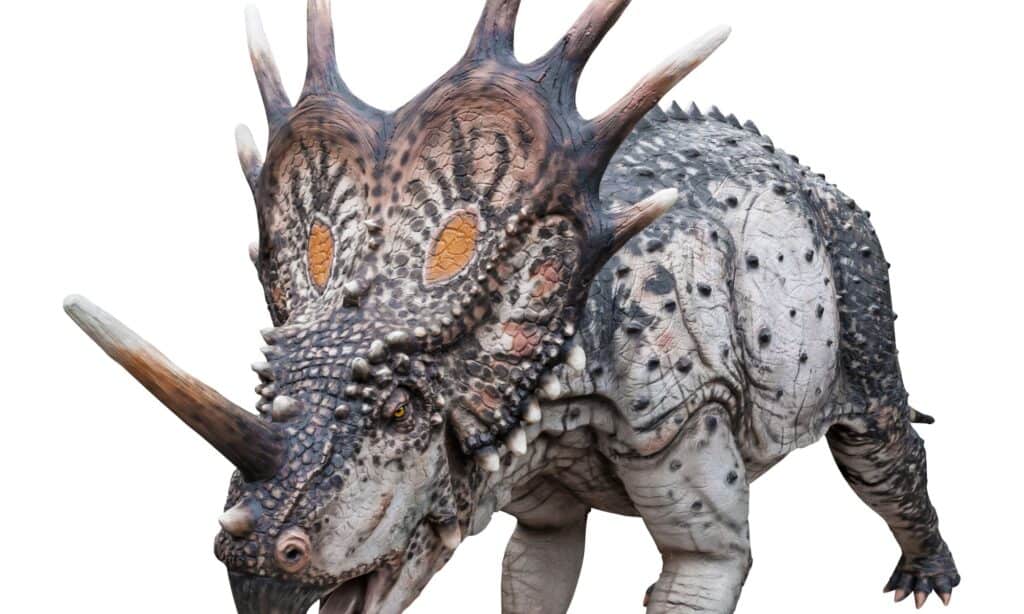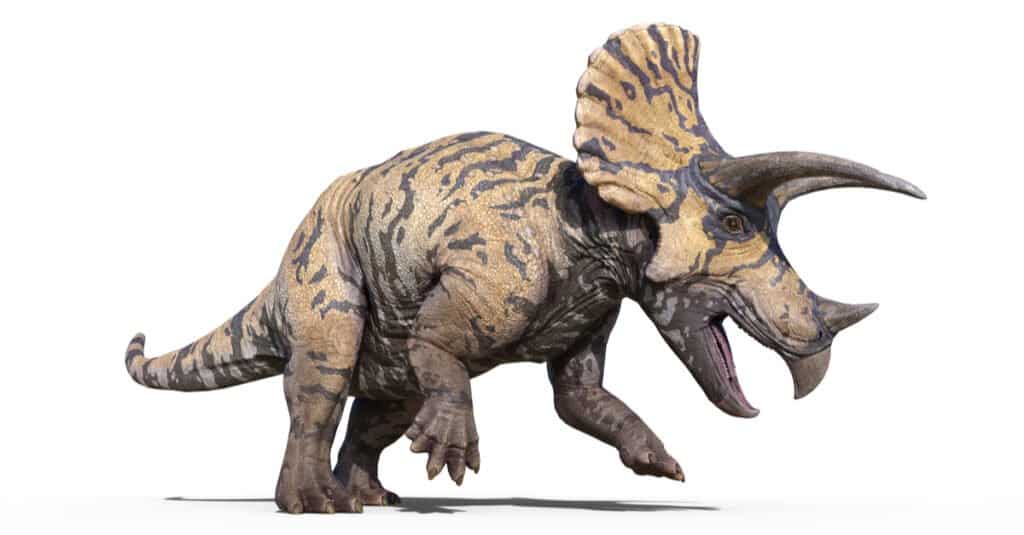Not all dinosaurs were large meat-eaters with a bite strong enough to crush a car. Some of these reptiles were large herbivores that wanted to find a meal and stay out of harm’s way. That doesn’t mean they were powerless or that fights between them if they had actually happened, wouldn’t be interesting. Today, we’re going to take a look at a battle between Triceratops vs Styracosaurus and demonstrate which of these herbivorous dinosaurs would win a battle and why.
We’ll break down the important factors and take an educated guess at what would happen if these two creatures came into conflict.
Comparing a Triceratops and a Styracosaurus

| Triceratops | Styracosaurus | |
|---|---|---|
| Size | Weight: 12,000lbs-20,000lbs Height: 9ft – 10ft Length: 25ft – 30ft | Weight: 6,000lbs Height: 5ft-5.9ft, up to 7ft including frill Length: 18ft |
| Speed and Movement Type | – 20 mph – Probably used an ungainly gallop | – 15-20 mph (estimated) |
| Defenses | – Massive size – Bony frill prevents damage to the neck | – Bony frill with protruding spikes measuring between 6 inches and 2ft – Spikes protruding from cheeks – Size |
| Offensive Capabilities | – Used horns and ramming to topple and kill enemies – May have fought against larger predators like T-rex – Could potentially use its weight to stomp on foes – Had two, 3-4ft-long horns on the head – Had a third horn measuring about 1ft-2ft long | – Large horn on the “nose” could potentially have been used to attack – Could potentially trample smaller attackers |
What Are Key Differences Between a Triceratops and a Styracosaurus?

Styracosaurus had one horn, and Triceratops had three horns on its head.
©Daniel Eskridge/Shutterstock.com
The most significant differences between a Triceratops and a Styracosaurus include their size and their morphology. Triceratops was a dinosaur that weighed up to 20,000lbs and stood 10ft tall with a large frill protecting its neck, two protruding horns, and a horn on its “nose”. Styracosaurus was a dinosaur that weighed about 6,000lbs and stood up to 7ft tall including its 2ft-long frill spikes that also had a 2ft-long horn protruding from its “nose” area.
These dinosaurs have some similarities, but we can parse the differences and get a good look at which was the stronger, deadlier animal in a fight.
What Are the Key Factors in a Fight Between a Triceratops and a Styracosaurus?

Styracosaurus had spikes protruding from the cheeks.
©YuRi Photolife/Shutterstock.com
The key factors in a fight between a Triceratops and a Styracosaurus include their size, speed, defenses, and offensive capabilities. We are going to explore these four elements, determine which of the dinosaurs was superior in each respect, and then use that information to decide the winner of the bout.
Triceratops vs Styracosaurus: Size
A Triceratops was larger than a Styracosaurus. The average Triceratops could stand up to 10ft tall, grew 30ft long, and weigh up to 20,000lbs. The Styracosaurus was a dinosaur that weighed about 6,000lbs, stood 5.9ft or up to 7ft, and measured 18ft long. The Triceratops weighed at least twice as much and was significantly larger.
The Triceratops has the size advantage in this fight.
Triceratops vs Styracosaurus: Speed and Movement
Estimates suggest that the Triceratops could run at speeds up to 20 mph using an ungainly gallop. This dinosaur was a quadruped, after all. Its powerful legs could help it build up speed, but it’s unclear how long it could maintain that velocity.
Unfortunately, we know very little about the movement speed of the Styracosaurus. We can only estimate that it could top out at about 15-20 mph.
The Triceratops has the speed advantage in this fight.
Triceratops vs Styracosaurus: Defenses
The Styracosaurus was a thick-bodied dinosaur that had some protections in its body. For example, the bony frill that protected its neck had several long spikes protruding from it, each measuring between 6 inches and 2ft long. This dinosaur also had spikes that protruded from its cheeks, too. These elements each protected the dinosaur, but it’s also possible that its frill was for temperature control rather than defenses.
The Triceratops also had a frill, but it lacked the large spikes of the Styracosaurus. Still, the frill would protect the Triceratops’ neck from carnivores. The massive size of this dinosaur was also an important type of defense that would keep smaller predators away.
All in all, Triceratops had more formidable defenses owing to their large size.
Triceratops vs Styracosaurus: Offensive Capabilities
The Triceratops was an herbivore that actually had rather powerful offensive powers. This dinosaur had three horns. Two of them were positioned pointing forward from its head, measuring 3-4ft long and the third was on the “nose” of the dinosaur and measured 1-2ft.
These horns and the frill may have been more of a mating signal than a weapon, but they could have been somewhat analogous to antlers in deer in that they were used to battle other Triceratops for breeding purposes.
Either way, the Triceratops could be dangerous by either stabbing other dinosaurs with their horns or trampling them.
Styracosaurus had a large horn on its nose, but the truth is that very little information about its purpose exists. If it did get into a fight for its life, the chances seem good that the dinosaur would attempt to use that 2ft horn to inflict some damage. Outside of that, it might be able to stomp otherwise use blunt force impacts to fend off others.
Who Would Win in a Fight Between a Triceratops and a Styracosaurus?

The Triceratops was too large for a Styracosaurus to handle.
©freestyle images/Shutterstock.com
A Triceratops would win a fight against a Styracosaurus. However, these two dinosaurs, even if they had lived at the same time and location, would probably not fight each other. The size difference and the fact that they are herbivores would limit the amount of conflict they had with each other.
Still, the first thing we have to consider here is the size differences. Triceratops was far larger, relatively fast, and almost certainly used its horns to fight other dinosaurs even if it was members of its own species. However, we don’t have the same information about the Styracosaurus.
In a battle, the Triceratops would probably charge the smaller dinosaur using its long horns and mighty power. A hit from this charge would jam the horns deep into the body of the Styracosaurus, causing severe internal damage and knocking over the smaller dinosaur.
That could be a killing blow. In fact, it would be hard for the small herbivore to shrug that off and counter. If it did try to attack again, the chances are that the Triceratops would renew its attack and perform another horn attack.
The smaller Styracosaurus could still do damage to the Triceratops if it was able to ignore its instincts to stay away from larger, stronger, and more dangerous dinosaurs. However, there is a much larger chance that the Triceratops would find the strength to counter this assault and turn the fight into an absolutely brutal affair.
In the end, either dinosaur could probably kill the other, but the Triceratops is the most likely winner.
The photo featured at the top of this post is © freestyle images/Shutterstock.com
Thank you for reading! Have some feedback for us? Contact the AZ Animals editorial team.






